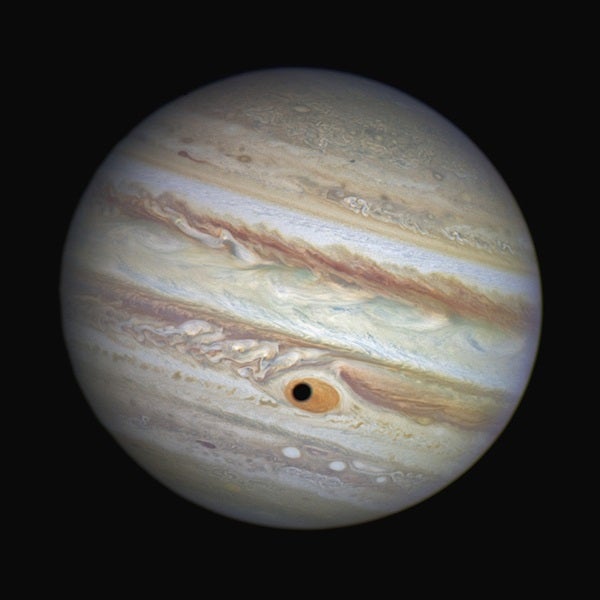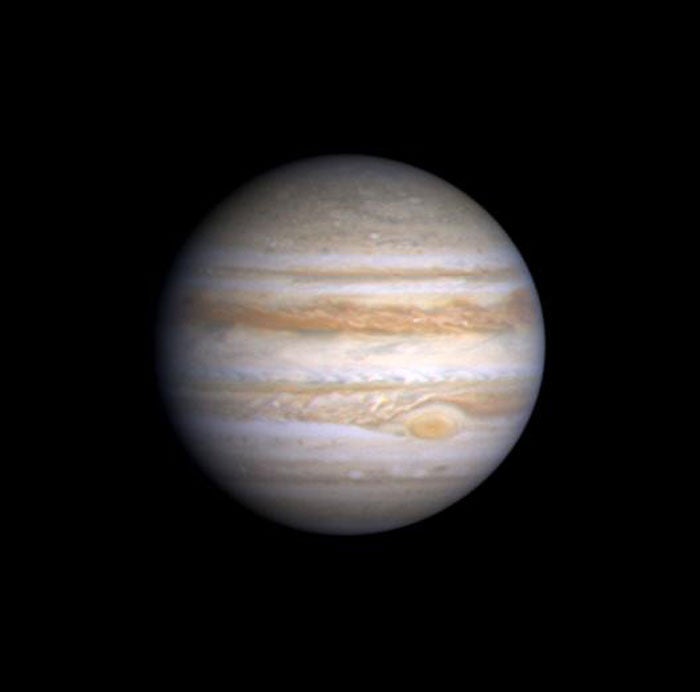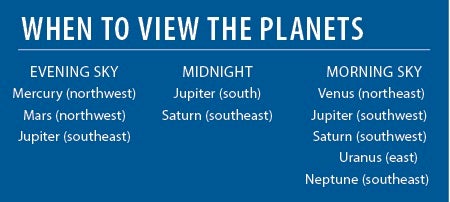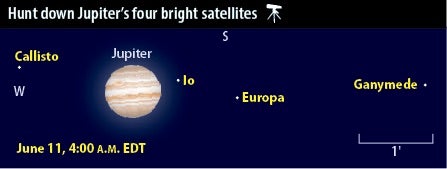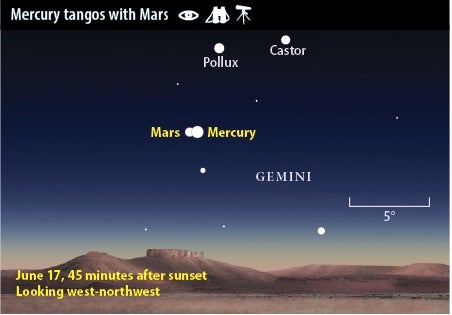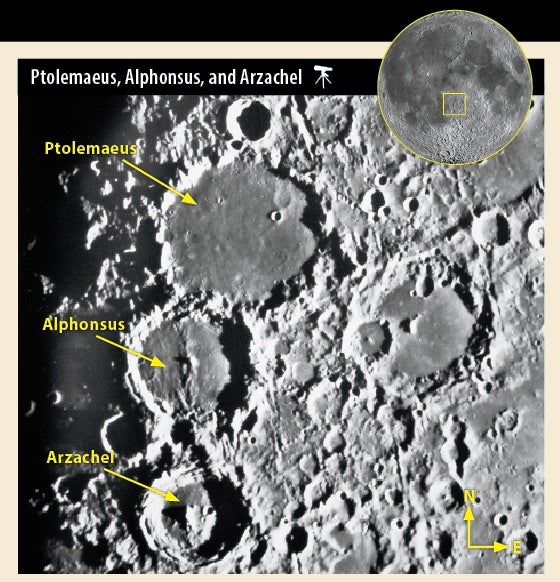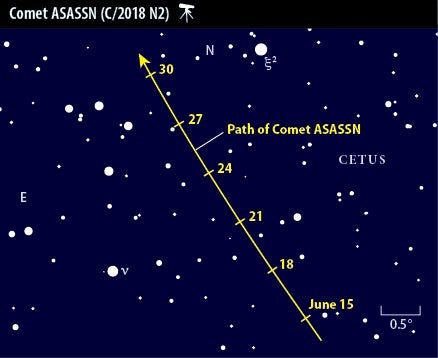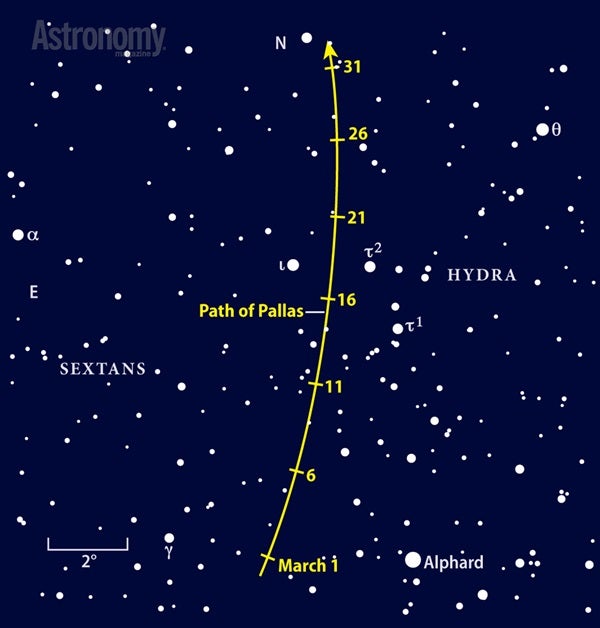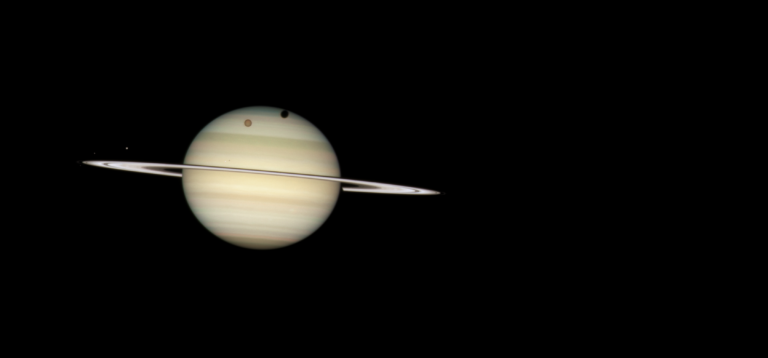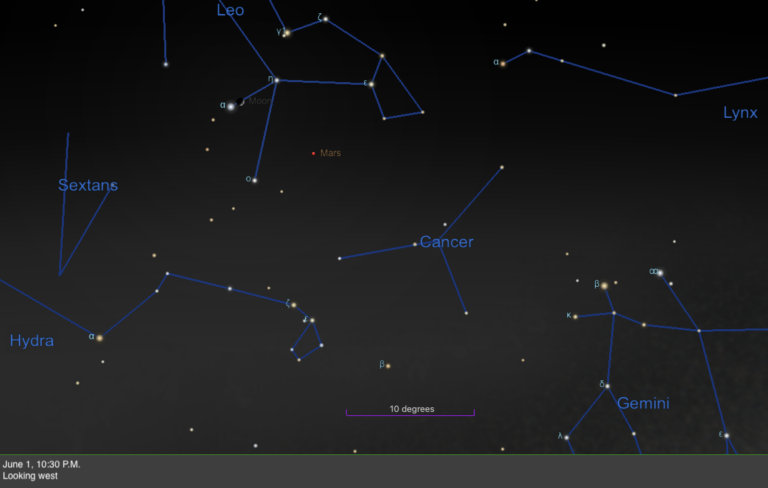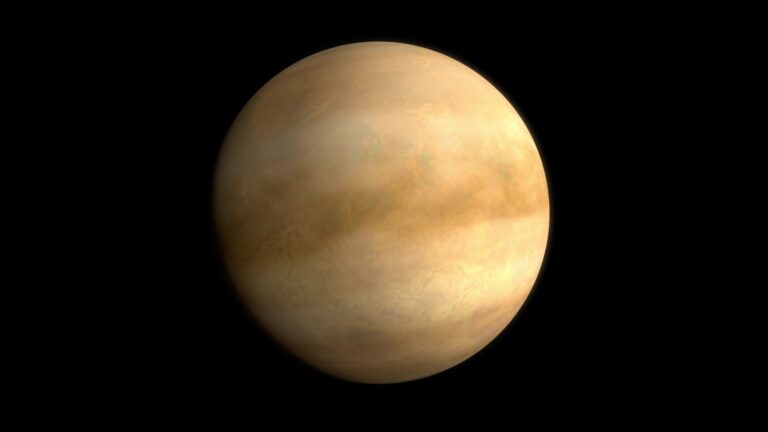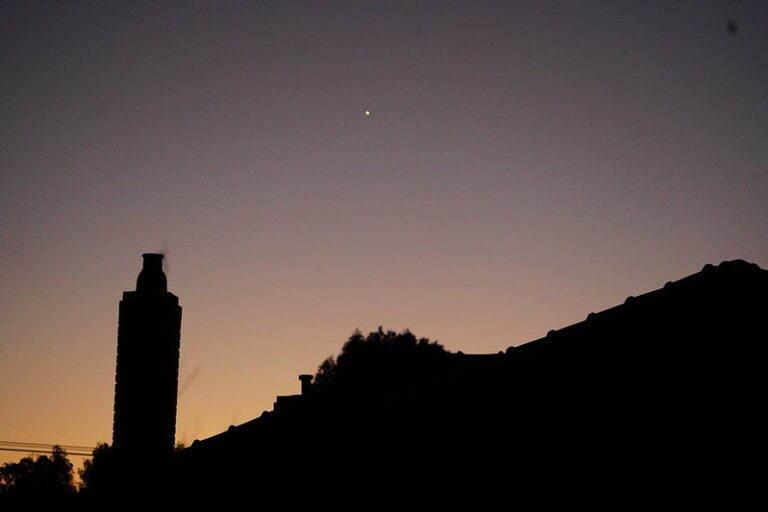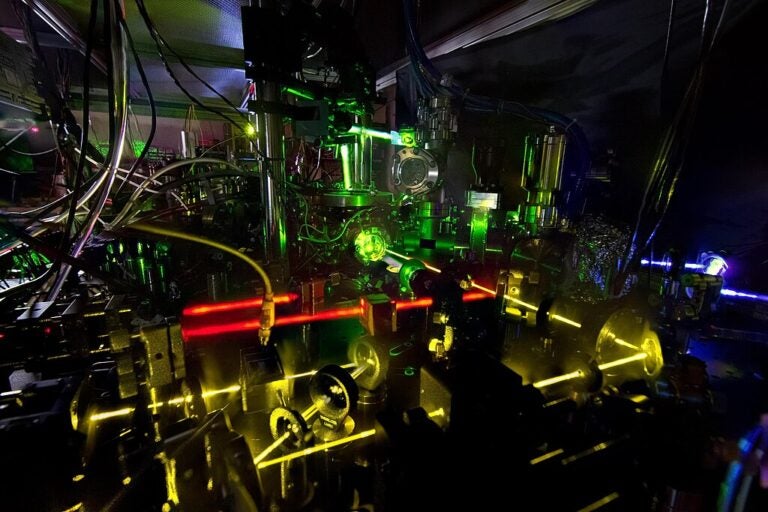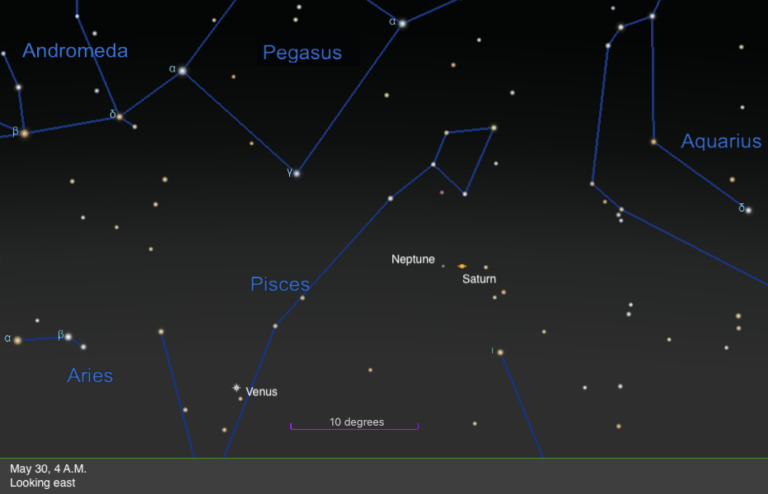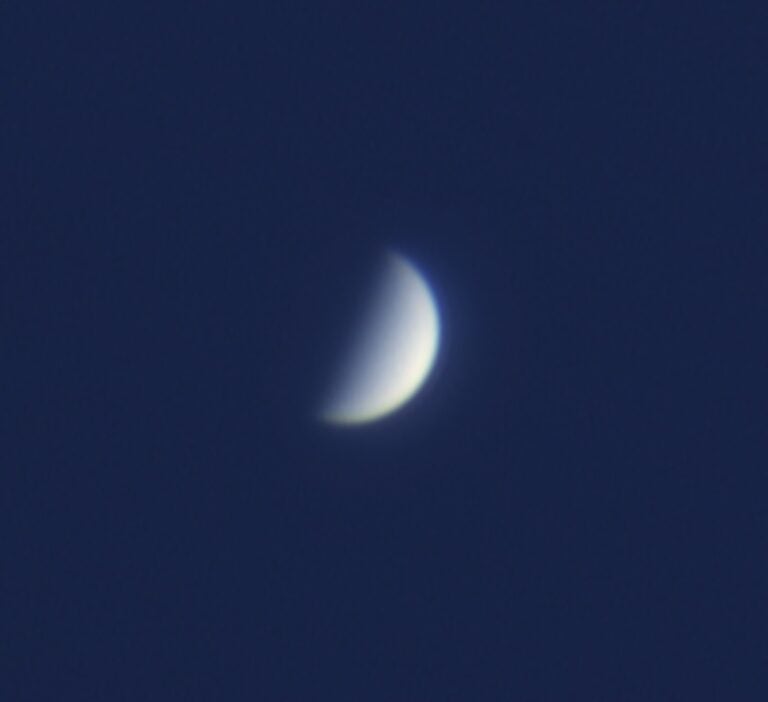But your first order of business these June nights should be to track down Mercury and Mars. On the 1st, Mercury shines at magnitude –1.0 and appears 6° high in the west-northwest a half-hour after sunset. It stands out quite nicely in the twilight glow. Four other objects join the inner planet. Capella, at magnitude 0.1 the brightest star in Auriga, stands 21° to Mercury’s upper right. Mars lies 16° to Mercury’s upper left and at the same altitude as Capella. Glowing at magnitude 1.8, the Red Planet may be hard to see in twilight without binoculars. Finally, the twin stars Castor and Pollux in Gemini appear 13° directly above the slightly fainter Mars.
A two-day-old crescent Moon joins the party June 4. Luna lies 6° to Mercury’s left, and both stand some 9° high 30 minutes after sundown. As the sky darkens, watch the unlit side of the Moon grow more prominent. This is earthshine — sunlight that bounces off Earth, hits the Moon, and reflects back to our eyes. The following evening, a slightly fatter crescent Moon appears 6° to Mars’ upper left.
Over the next two weeks, Mercury climbs higher and Mars drops lower. The solar system’s smallest planets are destined for a dramatic meeting just after midmonth. On June 17, the two appear side by side with 28′ — just less than the Full Moon’s diameter — between them. (This is the separation observers in central North America will see; the planets appear slightly farther apart from the eastern part of the continent and a bit closer from farther west.)
Following this close conjunction, Mercury continues to edge away from the Sun. It reaches greatest elongation June 23, when it lies 25° east of our star and appears 11° high a half-hour after sunset. It then starts to sink closer to the horizon, ending the month 3.8° to Mars’ left.
As Mercury and Mars set in the northwest, Jupiter rises in the southeast. The solar system’s largest planet comes to opposition June 10, when it lies opposite the Sun in our sky and remains visible all night. Opposition brings Jupiter closest to Earth, so it shines at its brightest for the year: magnitude –2.6. It brings a touch of brilliance to the otherwise faint constellation Ophiuchus the Serpent-bearer.
The sharpest views of the giant world come when it lies highest in the south. Jupiter peaks at an altitude of about 30° at 1 a.m. local daylight time the night of opposition. It reaches the same benchmark about a half-hour earlier with each passing week. Still, the planet lies nearly as high and the views are almost as good for a couple of hours on either side of these times.
Jupiter’s four brightest moons create a scene that changes dramatically from night to night. Their motions sometimes appear noticeable even within minutes, particularly when a satellite transits the planet’s face or lies near the limb.
The night of opposition offers a good opportunity to acquaint yourself with these so-called Galilean moons. If you look during the morning hours of June 11, you’ll see Io, Europa, and Ganymede lined up to Jupiter’s east while Callisto stands alone to the planet’s west.
Io’s transit begins at 10:22 p.m. EDT. Within five minutes, you should notice its shadow immediately to the moon’s east, with the two overlapping. Ganymede lies north of Io and begins to transit at 11:28 p.m. Its shadow falls on the cloud tops just southeast of the moon. Because Ganymede lies farther from Jupiter than Io, its shadow appears slightly more separated from the moon. Io completes its transit at 12:33 a.m., when Ganymede is about halfway across the giant planet’s disk. The outer moon completes its trek around 1:40 a.m.
Saturn lies 30° east of Jupiter, which means it trails about two hours behind its bigger brother. The ringed planet rises around 11 p.m. local daylight time June 1 and some two hours earlier by month’s end.
Saturn lies in northern Sagittarius, just south of that constellation’s Teaspoon asterism. It shines at magnitude 0.2 in mid-June and appears four times brighter than any of the Archer’s stars.
The best time to view Saturn through a telescope occurs during the early morning hours when it climbs highest in the south. Even the smallest telescope delivers stunning views. The planet’s disk measures 18″ across while the rings span 41″ and tilt 24° to our line of sight. Saturn’s disk shows little detail, though you might spot an equatorial belt and a dark polar hood.
Although Saturn’s moons don’t glow as brightly as Jupiter’s Galilean satellites, small scopes reveal at least four of them. Titan is the easiest. It shines at 8th magnitude and shows up through any instrument. This large moon orbits Saturn in 16 days, passing south of the ringed world the mornings of June 5 and 21 and north of the planet on the 13th and 29th. Look for three 10th-magnitude moons — Tethys, Dione, and Rhea — closer to Saturn.
Scan 60° east-northeast of Saturn and you’ll arrive at Neptune. The solar system’s most distant major planet rises shortly after 1 a.m. local daylight time June 15 and climbs 25° above the southeastern horizon by the time twilight begins. Neptune glows at magnitude 7.9, so you’ll need binoculars or a telescope to see it.
The outer world resides in northeastern Aquarius, in the same binocular field as magnitude 4.2 Phi (ϕ) Aquarii. It begins June 1.2° east-northeast of this star and crawls 0.1° farther away by the latter half of the month. This places the planet within 0.4° — slightly less than the Full Moon’s diameter — south of the magnitude 5.6 star 96 Aqr. When viewed through a telescope, Neptune displays a blue-gray disk that appears 2.3″ across.
Uranus slowly emerges into a dark sky by the end of June. On the 30th, it rises around 2 a.m. local daylight time and climbs 15° high in the east by the time twilight starts to paint the sky. The planet shines at magnitude 5.8 and shows up quite easily through binoculars.
The hardest part of finding Uranus is zeroing in on the right star field. The world lies in southern Aries, about 10° south of the Ram’s brightest star, magnitude 2.0 Hamal (Alpha [α] Arietis). This is a sparse area of sky, however. First locate 6th-magnitude 19 Ari, which lies 8° south of Hamal and shows up to the naked eye from under a dark sky. Center 19 Ari in your binoculars and you’ll see Uranus 2.4° to its south. To confirm your planet sighting, swing a telescope in its direction. Uranus shows a 3.5″-diameter disk with a distinctive blue-green color.
Morning twilight is well underway before our final planet appears. Venus rises an hour before the Sun on June 1 in the company of a slender crescent Moon. The two stand about 6° apart and a similar distance above the eastern horizon a half-hour before sunrise. Although Venus shines brilliantly at magnitude –3.8, the Sun’s glare drowns it out within the next 15 minutes.
Earth reaches its summer solstice at 11:54 a.m. EDT on June 21. This marks the instant when the Sun lies farthest north in our sky, and is the reason why the days are so long and the nights so short in the Northern Hemisphere.
A terrific trio of conspicuous craters
Three magnificent large craters beckon observers the evening of June 10, when the Moon is less than a day past First Quarter phase and appears slightly more than half-lit. The northernmost and largest of the three craters, Ptolemaeus, lies just south of the lunar equator. It sports a rugged rim that casts long shadows onto the relatively smooth floor. A small crater northeast of Ptolemaeus’ center affords a good test of your telescope’s optics and seeing conditions.
Like most large impact features, Ptolemaeus probably possesses a complex central peak — but you won’t see it no matter how hard you look. Lunar scientists suspect that it lies buried under deposits sprayed out during the excavation of giant Mare Imbrium to the northwest. You might also glimpse a few subtle depressions, telltale signs of ancient craters hidden under a blanket of debris.
The smaller impact that created Alphonsus immediately to the south of Ptolemaeus produces more distinct features and a higher central peak. Return to this feature every hour or so and note how quickly the spire’s shadow retreats under the rising Sun. The unusual ridge that bisects Alphonsus lines up with other linear features that point back toward Imbrium.
The youngest of the three craters is Arzachel to the south. Its rim and inner walls appear sharper than those of its northern neighbors, which suffered many more millennia of impacts.
Don’t hesitate to return to this region on subsequent nights. Although the higher Sun masks topographic relief, it reveals surface composition. Notice the handful of darker gray spots on Alphonsus’ floor. These are deposits of ash gently sprayed out during volcanic eruptions. Spectroscopic studies show the composition of the ash is similar to that of the lava that welled up to flood the large lunar maria.
Early summer’s twilight clouds
Despite the lack of major meteor showers in June, sporadic meteors continue to light up the sky. These random flashes arise when tiny grains of dust slam into Earth’s atmosphere and friction with air molecules incinerates them. Under a dark sky, observers typically see a half-dozen or so of these random meteors per hour.
Similarly fine meteoritic dust plays a role in producing summer’s gorgeous noctilucent clouds. These silver-blue clouds form about 50 miles up (10 times higher than cirrus), where Earth’s atmosphere is coldest, when ice crystals condense on dust particles. They typically appear in early summer from latitudes between 50° and 60° north. Search for them in twilight an hour or two after sunset, when our star still illuminates these high-altitude clouds.
A killer takes aim at the Whale
Comet observers often hope a new discovery will herald a bright target to feed their passion. This does happen, though not often. Two arrivals brightened to 9th magnitude in late 2018, but unless we get a similar surprise this month, we’ll have to be satisfied with a comet that reaches only 12th magnitude.
To catch Comet ASASSN (C/2018 N2), wait for the Moon-free period at the end of June. ASASSN — short for the All-Sky Automated Survey for Supernovae program — then resides in northeastern Cetus the Whale and rises about an hour before morning twilight commences. Look for the faint smudge of light as it glides northward between magnitude 4.9 Nu (ν) Ceti and magnitude 4.3 Xi2 (ξ2) Cet. Astronomers discovered this comet in July 2018, and it appears destined to peak at 11th magnitude this autumn.
A harder target lies on the border of Centaurus and Lupus in early June. Comet ATLAS (C/2017 M4) passes between magnitude 2.7 Beta (β) Lupi and magnitude 3.1 Kappa (κ) Centauri during June’s first week. You’ll need a 12-inch or larger scope to spot this 13th-magnitude object.
Tangled up in Berenice’s tresses
Asteroid 2 Pallas glows at 9th magnitude in June, making it a nice target for asteroid seekers. Visible with some effort through binoculars, it’s a cinch to find with the extra light-gathering power of a small telescope.
Pallas lies high in the south after darkness falls. To find it, first locate Arcturus, the magnitude –0.04 orange giant in Boötes that ranks as the night sky’s fourth-brightest star. Next, move 6.4° west-northwest to 5th-magnitude 6 Boötis, then another 2.4° northwest to 6th-magnitude 2 Boo. From there, cross the border into eastern Coma Berenices, Berenice’s Hair, and star-hop to Pallas’ position with the help of the chart below.
If you want to see the asteroid move in a single evening, June 12 and 26 offer the best chances. Both nights, Pallas skims near a similarly bright star that helps you gauge its motion.
When Heinrich Olbers discovered Pallas in 1802, astronomers thought it might be the second “missing planet” in what seemed like an abnormally large gap between Mars and Jupiter. Scientists later figured out that the gravity of massive Jupiter prevented any major planet from forming at that distance from the Sun.

